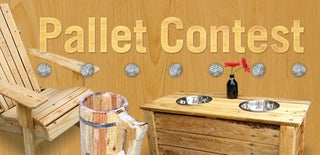Introduction: Pallet Wood Shelf/Coat Rack
The boards from pallets can be used in a multitude of projects but the side and center beams (also called "stringers") that are sandwiched between the top and bottom boards are a bit more difficult to use. When I decided to build a shelf/coat rack I looked at my supply of pallet wood and seeing the high stringer to board ratio I knew I had to incorporate these pieces of wood somehow. After looking at the notches cut into the sides (for forklifts) I knew they could be used to make a decent shelf quickly and easily.
Materials:
Wood Glue
1-2x Pallet Boards
1x Pallet Stringer (Middle Piece)
Dowel (Or similar sized wood for pegs)
Stain (Optional but I used Minwax Ipswich Pine and English Chestnut)
Polyurethane (Optional but I used Minwax Fast Drying)
Tools:
Saw (I used a miter saw and a jig saw)
Power Drill (With 1/2 in Bit)
Chisel
Hammer
Tape Measure
Pencil
Paint Brush
Sand Paper
Step 1: Design and Cutting the Wood
For the design I knew I wanted at least two shelves and at least two coat pegs. After measuring the space I wanted the shelf, I decided on a width and height. I cut the boards for the shelves and frame with a miter saw but any saw will do. I decided to have the bottom of the frame go down at an angle towards the wall, leaving about an inch of wood coming out from the wall.
Step 2: Cutting the Notches for Shelves
After measuring the thickness of the shelf boards I marked them on the frame and used a jig saw to cut into the frame wood. I cut two lines into the wood and then used a hammer and chisel to knock out the piece of wood then I checked the notch size by sliding the shelf board into it.
Once the four notches have been made on the frame, four notches must be made on the two shelves. I measured the width of frame and marked it on the shelves. Just like before I cut lines into the board (three this time because of the greater width) and knocked out the pieces with a hammer and chisel.
Once all the notches are cut the shelves and frame should fit together snugly.
Step 3: Sanding, Gluing, and More Sanding.
With everything cut it's time to sand all the pieces. While sanding every piece is optional, at the very least the wood around the cuts should be sanded to get rid of any large slivers. I wanted a particular color scheme for the wood so I decided to sand every piece until they were nice and smooth so the stain would take to the wood well.
After dry fitting everything together, some glue may be added inside each notch for additional strength. This is optional because if the notches fit snugly enough together, they should hold without it.
If glue or wood filler is used to fill in any spots, more sanding will be needed.
Step 4: Adding Pegs
For the pegs I cut two pieces off of a dowel, about 6 inches long each. The dowel I used was 5/8 inch but the largest hole that would fit in the wood was 1/2 inch so I used a chisel to take off excess wood around the last two inches of the peg until it would fit into the 1/2 inch hole (which I drilled at an angle) The pegs fit so well in the holes that I did not use any wood glue.
At this time the holes for hanging the shelf/rack can be drilled in the back of the frame. I chose do put them below the top shelf and at an angle so a nail in the wall angled up will slide into them.
Step 5: Staining and Applying a Finish
I wanted a two tone look so I applied a lighter stain to the shelves and pegs and a darker stain to the frame. After this I applied a couple coats of polyurethane to give it a nice gloss.
The final step is to hang it up and enjoy!

Participated in the
Pallet Contest

Participated in the
Green Design Contest













